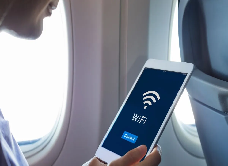In a recent announcement, there’s a big surprise for adventure lovers who are always on the go. If you hate sitting idle and switching off your cellphone on your flight, it’s good news for you! The Department of Telecommunications (DoT) in India has collaborated with other regulatory bodies and has taken a major step forward. The DoT has finally given the green light to Wi-Fi services on aircraft. So, no more boring flights; you can watch your favorite movie, listen to all the evergreen songs, and spend your time without cutting off your social life.
India has been working tirelessly in recent years on a plan to enable in-flight Wi-Fi connectivity for passengers. The government of India had to amend and make some changes in the regulatory environment to make it legally possible. Especially when the aircraft is flying over Indian airspace.
The Changes Done To Bring Wi-Fi On Aircraft
Previously, the Indian government had mandated that in-flight and maritime internet connectivity providers could offer the service on aircraft at a minimum height of 3,000 meters in Indian airspace.
Now, the DoT will regulate the rules and amend them, while making every effort to ensure safety, as airlines must follow strict regulations to avoid interference with aviation communication systems.
“Notwithstanding the minimum height in Indian airspace referred to in sub-rule (1), internet services through Wi-Fi in aircraft shall be made available when electronic devices are permitted to be used in the aircraft,” as per the new rule notified.
According to the statement by DoT, This new rule will be called- The flight and Maritime Connectivity (Amendment) Rule 2024.
Who Can Use The Internet On The Flight?
With the recent setup, there is clarification that passengers can use Wi-Fi services during flight, but only on a few selected devices. The electronic devices that you can use, such as smartphones, tablets, and laptops, must be authorized for use by the crew, regardless of the altitude.
This setup aligns with safety protocols surrounding the landing and take-off of the flight. This will also avoid any interference during the critical phases of the aircraft. The new amendment will ensure that both connectivity and safety are intact.



